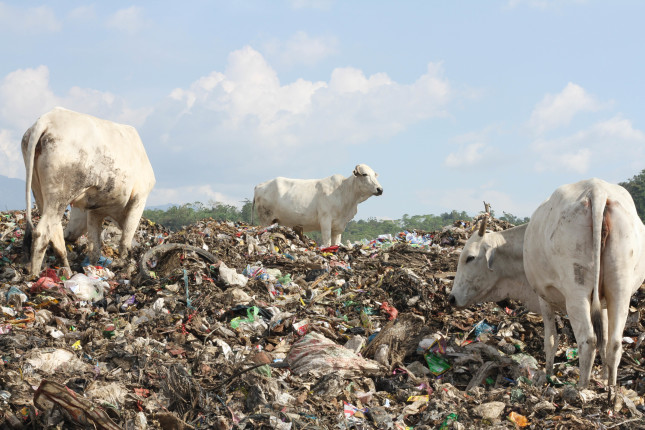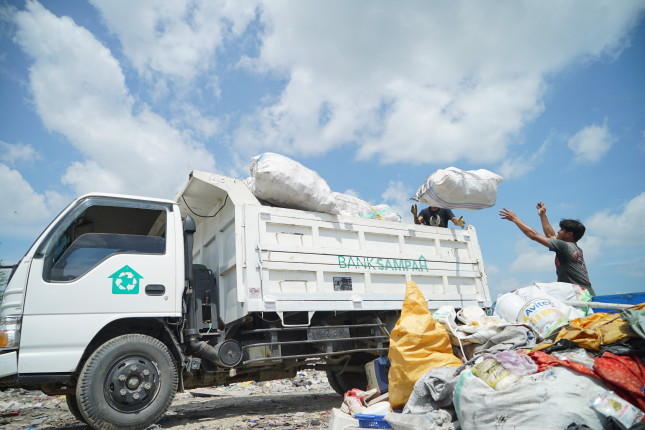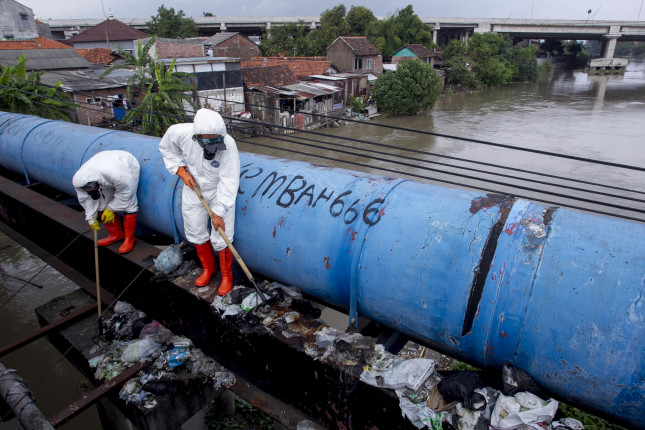-
Turning the Tide: How Can Indonesia Close the Loop on Plastic Waste?

Indonesia. Crystal blue waters, palm trees swaying in the wind, endless sandy beaches, lush tropical jungles, towering mountains, lakes, rivers, and more; all are images that may come to mind when you think of Indonesia. But like other Asian countries, Indonesia’s booming development and increased consumption have generated an immense amount of waste, particularly single-use plastics that are leaking into the ocean.
In her conversation with Indonesian journalist Basten Gokkon, the lead article in the InsightOut publication, Yuniati, a fisherwoman from Sulawesi, somberly reflected, “the plastics we dump now may not impact us today, but will harm the next generation.”
While Indonesia’s plastic challenges are momentous, there are big efforts to tackle it. A new China Environment Forum InsightOut issue shines a light on these efforts, featuring Indonesian, Japanese, and American authors who share policy innovations, partnerships, financing and community engagement emerging in Indonesia. The publication aims to offer valuable insights for China and other Asian nations struggling with the plastic waste challenge.
An Indonesian Plastic Waste Challenge
Indonesia is now second behind China as a source of ocean plastic, responsible for 10 percent of global plastic leakage. While local governments in Indonesia are nominally responsible for waste management, this is a difficult task when collection is spread across 17,000 islands with limited available land and tax revenue. Tsuji Keitaro, an expert with JICA, writes in the new InsightOut that the majority of Indonesia’s urban landfills are overflowing, and this is a major source of leakage cities must address.
Currently, 60 percent of plastic waste is mismanaged in Indonesia, 80 percent of which will end up being burned or buried. Ultimately, only around 10 percent of generated plastic waste gets recycled. During his research trip to Indonesia’s idyllic Lake Toba, waste expert Tsukiji Makoto and his team found more than 10 open waste dump sites, underscoring the lack of rural waste infrastructure. According to Michikazu Kojima, a waste expert at the Jakarta-based think tank ERIA, regional cooperation among municipalities could expand the web of waste management services to collect rural plastic waste in Indonesia.
Ocean Conservancy’s Trash Free Seas clean up in Indonesia found that the bulk of plastic waste pollution comes from food wrappers, straws, bottles and bottle caps, plastic bags, and small sachet pouches. Sachets, small flexible pouches made of multiple layers of plastic, are a particularly troublesome product due to their low value. They account for 16 percent of plastic waste in Indonesia’s environment, and even more in some other ASEAN countries.
After years as the world’s largest plastic waste importer, China passed its National Sword Policy in 2018 and began banning all plastic waste imports. This sparked a shift in European, American, Canadian, and Australian plastic waste exports to Southeast Asia. While most of Indonesia’s plastic waste is generated domestically, these foreign plastic imports have added stress to the country’s already overburdened waste management system.
Closing the Loop in Indonesia on Plastic Waste
Over the past few years, grassroots, policy, and business action have exploded to take on Indonesia’s plastic waste problem. In the summer of 2020, Indonesia’s Ministry for Maritime Affairs and Investment worked with the World Economic Forum to produce a comprehensive roadmap for Indonesia to reduce the country’s plastic waste 70 percent by 2025 and to reach net-zero plastic waste by 2040. GAIA’s Yobel Novian Putra and many other grassroots activists in Indonesia have been advocating for greater “upstream” action to reduce plastic production. Yobel argues that the plastic waste crisis is “beyond littering and we cannot afford to waste time solving the wrong problem.” Encouragingly, the Indonesian government is moving to slow the production of single-use plastics in the passage of a national enhanced producer responsibility action plan that makes it more costly for companies to sell plastic packaging. The action plan will require companies to manage their plastic packaging from cradle to grave with the goal of lessening the burden on cities to manage waste and motivating companies to make packaging with less or no plastic.
Indonesian grassroots groups and zero waste innovators are putting the brakes on single-use containers by opening bulk stores where consumers bring their own containers for products. Indonesian NGOs and companies like Unilever are also working on downstream plastic waste issues to stop ocean plastic leakage by running waste banks to divert plastic from landfills. Indonesian river keepers are collecting data, performing cleanups and sometimes successfully suing polluters in court. The expanding youth-led grassroots initiative Divers Clean Action has led education campaigns in Indonesia that have fostered collaboration between communities and local governments to fight for a plastic-free ocean.
Shining a Light on Cities and Plastic Data Gaps
International efforts are working to build waste management capacity in Indonesian cities, such as USAID’s Municipal Waste Recycling Program and a new Clean Cities Blue Ocean Initiative. The latter was launched in 2021 to build city waste management capacity, improve 3R investments, and empower women leadership to combat plastic leakage. One USAID partner, Circulate Capital, has been incubating new investable opportunities to improve waste value chains in Indonesia and to increase investments into urban waste collection systems, processing technology, and creating a “second life” for post-consumer plastic materials. The U.S.-based Ocean Conservancy set up an Urban Ocean initiative to improve municipal waste management systems through science-based processes and partnership building in Vietnam and Indonesia.
Better data will be crucial to solving Indonesia’s plastic waste problem. For example, to help highlight the threats of plastic and communicate the significance of the problem, the Goldman prize winning activist Prigi Arisandi has collected data from field monitoring and interviews with scrap sorters along the Brantas River. He discovered that the increase in imported paper bales mixed with plastic waste is exacerbating plastic pollution in the river, threatening the ecosystem and human health. The Minderoo Foundation’s Global Plastic Watch, done in partnership with the U.S. Department of State, NOAA, Plymouth Marine Institute, and other international partners, is using satellites and citizen scientists in Indonesia to help track and map plastic leakage hotspots and measure the amount of plastic in the ocean. Better data can help guide policy and measure the impacts of plastic mitigation policies.
Eli Patton is a researcher at Wilson Center’s China Environment Forum. His research focuses on the environmental and security aspects of China’s FDI. Eli will graduate from the George Washington University with an MA in Asian Studies this spring.
Ruyi Li is a researcher at the Wilson Center’s China Environment Forum. Her recent focuses are waste management in Asia and the low-carbon transition in China and the US. She graduated from Johns Hopkins University (SAIS) with an MA in Energy, Resources & Environment.
Sources: Our World in Data, World Economic Forum.
Lead image credit: Cows in a plastic landfill, courtesy of USAID.
 A Publication of the Stimson Center.
A Publication of the Stimson Center.










